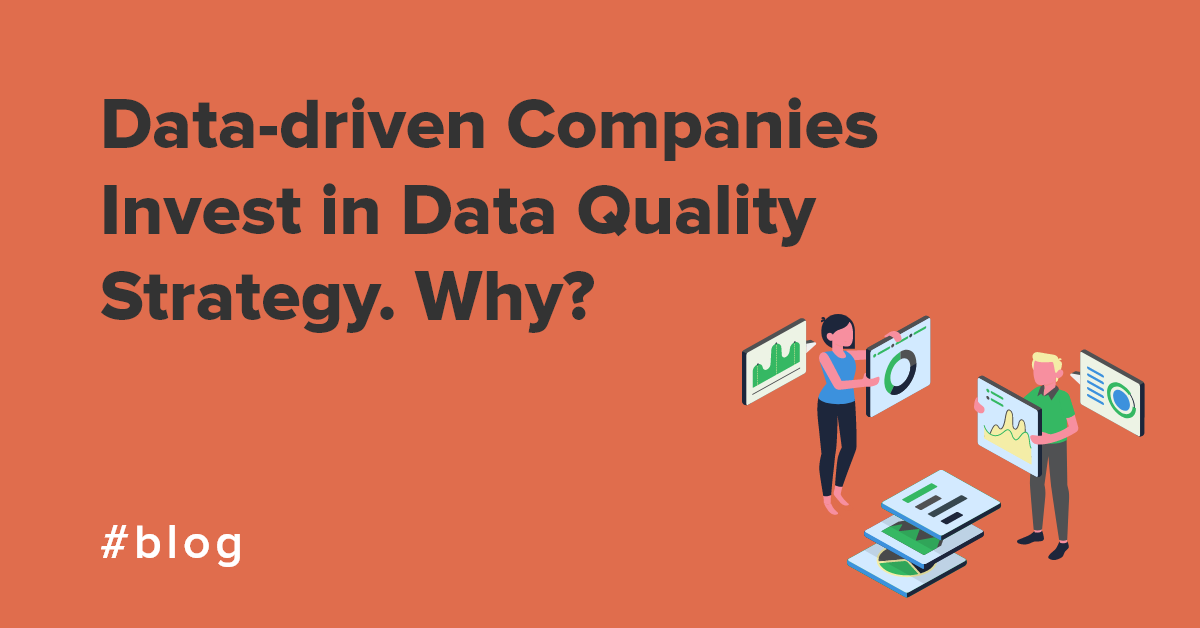Is data quality an integral part of your data-driven business strategy? Chances are, not completely—not yet, anyway. Nearly 40% of all company data is inaccurate, yet we know full well that the quality of data has a direct impact on how valuable insights are. By working with dirty data, companies run the risk of polluting their results and decisions.
Time spent manually fixing mundane data quality issues. Legal and compliance implications. Misallocation of budget. It's important to not underestimate these outcomes.
To mitigate big losses, create data that the business can rely on and improve data quality metrics, companies now more than ever are investing in comprehensive, future-oriented data quality strategy. In this blog, we’ll share some real life examples of three companies who deployed customized data quality solutions to decrease inefficiency and promote long-term growth.
1. Incorporating Data Quality Strategy in Data Workflows
Developing a proactive data quality management process rather than manually reacting to issues along the way more often than not yields better results. A lot of companies seek solutions to optimize their workflows, decrease time spent on manual data management, and of course, save some money.
Case study: Data quality for data migrationsFor example, consultants from a leading Workday implementation partner, migrating data from legacy systems to Workday had become an expensive time sink. Workday’s stringent rules about the type of data it receives was an issue, but the main difficulty was dealing with the legacy data, rife with errors and inconsistencies, that the consultants were tasked with migrating. Deploying an ingestion and validation framework helps considerably. It not only validates, but also transforms arbitrary customer data into a Workday-friendly format automatically.
With data quality checks built into the greater workflow, consultants spend considerably fewer billable hours on manual data prep and can return to their core responsibility—implementing Workday.
2. Thinking in Terms of Unique Goals and Growth
Clean data good, dirty data bad, right? True, but if you want to really have a worthwhile strategy, planning needs to go a level deeper. How will your data strategy support your larger goals and long-term growth? Which areas of your business feel data issues most acutely? Let’s take a look at one example of a data quality solution that has growing pains as its driving force.
Case study: Address validation and cleansingA data quality team of 30+ workers from a fast-growing logistics company was manually cleansing and validating tricky address data. With expansion to new regions, manual validation under tight deadlines was just not sustainable. Higher volumes of data combined with disparate address structures stalled growth, leading the company to seek a solution to replace the bottlenecked process.
The solution, a scalable address validation and cleansing framework, is adaptable to country-specific rules and automatically validates, geo-locates, and repairs addresses with near-real time processing. It has solved the pains of manual data processing, minimizing human interactions down to 1/10th, a figure that’s still decreasing with the system’s self‑learning capability. When you rely on data as you grow your business, it should be more than good enough; it should solve the problems standing in the way.
3. Considering How Poor Quality Data Affects Credibility
Legal and financial implications of poor quality data often dominate the conversation, with good reason. But its adverse effects often trickle through all aspects of the business. In this next case, a publishing house sought an address validation and cleansing solution to grapple with a loss of credibility and missed opportunities related to their underperforming direct mail marketing campaign.
Case study: Data cleansingThe solution checked all their mailing address, rectified incorrect ones, verified other customer data like emails and phone numbers, found duplicate entries in the customer database, and worked with external databases to provide further customer information enrichments.
This improved the overall efficacy of their marketing campaign deliveries, leading to savings of more than $800,000 and a 12% increase in orders. When weighing the cost of a solution against its long-term benefits, both direct and indirect damages associated with poor quality data should be duly considered.
CloverDX Supports the Future of Data Quality
As data grows in scale, with less structure and more variation, businesses are experiencing the negative effects of dirty data on their analytics more than ever. With its integrated toolset, CloverDX can help out.
CloverDX Validator, for example, is a smart component for automated data movements. With a quick drag and drop, you can use it to nestle data quality among all other processes in the workflow to ensure that all the data flowing through your pipelines has better data quality so you can get better business insights. Validator lets you to visually specify a set of repeatable data quality rules to check criteria like date format, numeric value, interval match, phone number validity and format, and more. Validator's actionable rejects reports then provide detailed descriptions on anything the filter doesn’t let through.
Learn more about data quality with CloverDX in this video.
Comprehensive, integrated data quality is not just something to consider in the future, but a valuable endeavor to invest in now. If you’re looking to think differently about your data, we’d be happy to chat.









